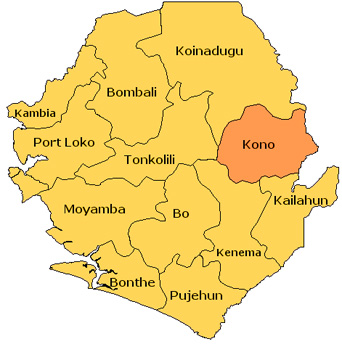
The historical records seem to show that Kono district has always functioned as a predominantly SLPP support base. This has been the case despite the inception of the Kono Progressive Movement (KPM) that was led by Tamba Sungu Mbriwa.
The KPM, which is so far the only independent effort of the Kono elite to constitute a real political organization of their own, was itself unable to fully defeat the SLPP in Kono district. And the KPM had serious politicians in the likes of Tamba Ngegba, J.S. Kpakiwa and T.R. Foyoh.
In the 1957 elections, for example, KPM contested for two parliamentary seats in Kono. T.S. Mbriwa won one of the contested seats, while A.A. Mani lost to the SLPP candidate Paul Dunbar by a margin of 3105 to 3061 votes. Dunbar, however, was prevented from taking his seat in parliament because colonial officials had accused him of corruption and they actually preferred Mani instead of Dunbar in the legislative assembly. So, A.A. Mani went to Parliament through a forced by-elections in which he contested and won against Dunbar’s wife, who was not a formidable candidate.
The voting trends in Kono have seemingly remained unshakenly SLPP dominated since the 1960s. This is because Kono is yet to produce a politician or political organization that tries to organize outside of the cultural boundaries of “Konoland” and one that sees the “Kono question” as part of the national question itself. Whatever that means is itself a subject of debate.
Abu Aiah Koroma was more sympathetic to SLPP even though his career as a lawyer and an administrator may have started under the APC one-party dictatorship of the 1960s and 1970s. Abu Aiah Koroma’s Democratic Centre Party (DCP) got only 4.9% of the national vote in the 1996 elections, and he was later co-opted by the SLPP of Ahmed Tejan Kabbah who appointed him Minister of Political and Parliamentary Affairs, a position he held until the 2002 elections.
Since Mbriwa and Aiah Koroma, Kono district hasn’t really presented a real formidable political figure. We must underline that Sam Sumana wasn’t a politician; he was a fledging businessman drawn into politics by the APC and he considers himself an APC even though the Coalition for Change (C4C) that he led in 2018 as a presidential candidate did create an upset in the elections of 2018 in Kono district. However, it is my view that anyone could have caused that upset in “Kono country” by 2018 because of the way Ernest Koroma and the APC treated the Kono people between 2012 and 2017. We all know the full details of the conflict that governed Kono politics during Ernest Koroma’s tenure as president.
Thus, the elections of 2018 are an exception in Kono politics due partly to the excesses of the Ernest Koroma regime in Kono district. That exception can be compared to the PMDC upset in the elections of 2007 that brought Ernest Koroma to power. Both parties were not really organized to win the national elections but they were mostly pulled together to prevent incumbent candidates (Berewa in 2007 and Samura Kamara in 2018) from actually becoming presidents. They did achieve their primary objectives. But once that goal was realized, the question of their future ultimately reached the rocks!!
That said, the electoral dynamics in Kono still remain as they were in the 1950s and 1990s. They haven’t significantly changed even with a Vice President from Kono.
However, there are areas in Kono district where opposition parties like the APC can really generate significant votes. These areas are mostly in mining communities that include Sewafe and its surrounding communities. It is also possible to generate APC votes in places like Sandiya, more so than in places like central Koidu town.
The demographic and ethnographic configuration of Kono district makes it feasible for the SLPP to always and easily generate more votes from Kono district than other political parties. We can check the recent electoral statistics, at least from 2007 to 2018, to study this pattern of voting. If you disaggregate the electoral statistics by constituencies and wards, these voting patterns can illuminate precisely where opposition parties, like the APC, can potentially find clusters and pockets of voters in Kono district that may likely vote against the SLPP.
These are just my brief thoughts on the subject. Happy weekend to all of you!!
Chernoh Alpha M. Bah
Africanist Press
USA
~~~~



